
| UPDATES | GUEST BOOK | MEMORIES | MORE PICTURES | OTHER LINKS | BIBLIOGRAPHY | ||
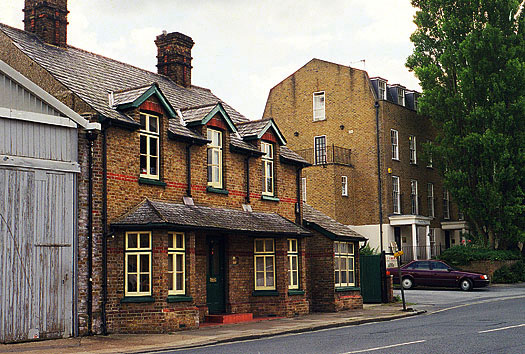

![]()
In 1880 the only direct link between Causeway and the town station was Dell Lane, a narrow, cobblestone thoroughfare bordered on both sides by small houses and a large malting at its northern end. That same year a decision was made that Dell Lane should revert to its original and ancient name of Dane Street, though how ‘ancient’ it was thought the name Dane Street might be is unclear. It’s not likely to have had any link with the Danes, who may or may not have been in this area in the 9th and 10th centuries, but there was a John Dane, who in 1630 left a bequest in his will regarding land at Hockerill. See separate note
In the early 1920s a proposal to make this route to the station more accessible to traffic resulted in Mr Sylvester Edwards (owner at that time of Edwards flour mill) selling the land he owned between Dell Lane and Hockerill Street at Sworders public auction in 1922 (HALS REF D/ETE B123). Most houses here were then demolished including the Black Bull Inn that stood at the corner of Dane Street and Hockerill Street, as was part of the malting.
Not included in the auction sale was a cottage and corn shop at the north end of Dane Street that fronted Hockerill Street. These were retained by the council, who in 1926 built new headquarters for the Guardians of the Union Workhouse – now No 2 Hockerill Street which houses the Register Office.
That part of the malting not demolished was occupied in the late 1920s by L.J. Sheppard. He began his business as a motorcycle agent and car repairer. In 1969 the company became a Volkswagen retailer, with part of the original malting forming their car showroom. The business was taken over by the Vindis Group in 2003.
The name Sheppards was retained but on 31 October 2012 the business closed for good. Part of the reason for this was due to the new requirements set out by the Volkswagon Retailer Standards. These included accommodating a 300 sq m internal vehicle display, for which Sheppards just did not have the space. Directors considered relocating, but this was deemed to be financially unjustifiable.
The small building with its gable jutting out above the footpath was also once part of the same malting but later became a shop. This is probably best remembered by local people as Woodford’s the butchers, owned in the 1940s by Charlie Woodford who had his portrait painted by local artist *John Kynnersley Kirby. Entitled ‘The Week’s Ration‘ and exhibited at the Royal Academy, London, it portrayed the suitably attired Mr Woodford in his shop about to wrap-up a small meat chop that lay on the counter in front of him. These were the war years and the painting was a depiction of food rationing – a necessary law imposed on the public at that time. The painting was also used to illustrate a topical rhyme about food rationing that featured on a Second World War calendar produced by publishers, Raphael Tuck.
When we queue for our chop in the Butcher’s Shop
Our thoughts turn to days of old,
With their choice of Chump or juicy Rump
Of saddle or Sirloin bold,
But as our JOINT efforts are helping the war
In no uncertain fashion,
The CUT’S worthwhile, so with WINNING smile
We take our weekly ration!
In Germany, Joseph Goebels apparently used the same picture for propaganda purposes, emphasising the fact that the British had very little food due to the Atlantic U-boat campaign that was sinking supply ships from America. Later owned by Mr Woodford’s son, the butcher’s shop remained in business until the mid 1980s.
In September 2009 the original painting of Mr Woodford came up for auction sale in Nottingham. In a bid to secure it for Bishop’s Stortford museum, curator Dr Sarah Turner quickly launched a fighting fund – promises of funding coming from the Hertfordshire Heritage Fund and the Brazier Trust in Stortford. Had the auction house valuers estimate of £800–£1,200 been accurate, the painting may well have now been hanging on a prominent wall in the museum. It actually sold on the telephone to an anonymous buyer for a staggering £8,000 – way beyond what Stortford was willing to pay for it.
*See John Kynnersley Kirby – Guide 11
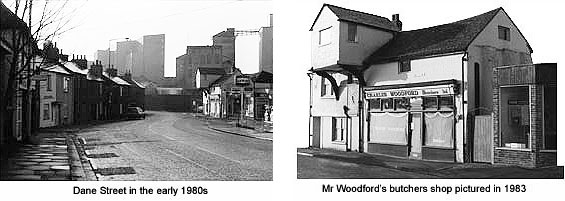
Modern buildings of traditional style occupy the north-east side of Dane Street, but up until 1902 this was the site of a 17th century alehouse called the Old Barge. It was owned in 1867 by Ann Perry and in 1888 by a Mrs Pickett. The adjacent terrace of 19th century houses is all that survived demolition when the road was widened in the 1920s.
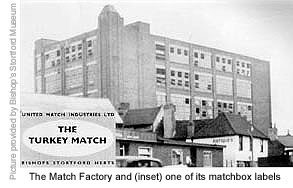 From at least 1776 until 1837, the land behind these houses was the site of Hockerill workhouse (See Guide 9 – Hockerill Workhouse). Malsters H A & D Taylor then bought the site, converting the former workhouse buildings for use as a malting. When their production here ceased around 1910 the property was purchased by a manager of Messrs Glasscock – a former building firm in Causeway. He used it as a rope and sisal works until shortly after the First World War when his business folded.
From at least 1776 until 1837, the land behind these houses was the site of Hockerill workhouse (See Guide 9 – Hockerill Workhouse). Malsters H A & D Taylor then bought the site, converting the former workhouse buildings for use as a malting. When their production here ceased around 1910 the property was purchased by a manager of Messrs Glasscock – a former building firm in Causeway. He used it as a rope and sisal works until shortly after the First World War when his business folded.
In 1923 a Mr C. F. Holeworth bought the site for use as a match factory. He was later joined in partnership by a Mr Edwards – probably Sylvester Edwards who owned Edwards flour mill in Dane Street. But for reasons unknown they didn’t name their company after themselves, instead calling it E. H. King & Company. Who the mysterious Mr King was has never been established, but the factory thrived and in 1928 was taken over by a group of ‘interested’ people who formed a public company named United Match Industries Ltd.
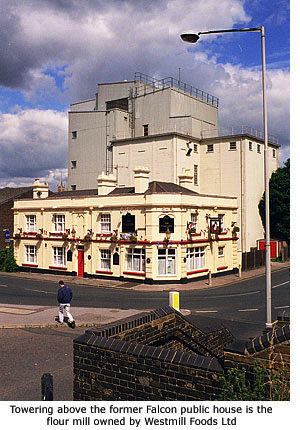 The following year they built a modern factory on the site, supposedly based on Bryant & May’s match factory at Bow in East London. And just like the factory in London, it was ideally situated next to the river for easy delivery of logs needed to make the matches. The fact that the factory was a distinctive blot on the townscape for forty years doesn’t really matter. More importantly it provided countless local people with regular employment. One particular brand of matches produced here was called Dunyerbit, referring to the fact that a large part of the workforce was made up of ex-servicemen.
The following year they built a modern factory on the site, supposedly based on Bryant & May’s match factory at Bow in East London. And just like the factory in London, it was ideally situated next to the river for easy delivery of logs needed to make the matches. The fact that the factory was a distinctive blot on the townscape for forty years doesn’t really matter. More importantly it provided countless local people with regular employment. One particular brand of matches produced here was called Dunyerbit, referring to the fact that a large part of the workforce was made up of ex-servicemen.
But by the late 1960s the factory’s profits were dwindling, and on 11 September 1970 the company went into voluntary liquidation. At auction on 27 January 1971 the site was bought once again, this time by a property developer who demolished the factory in early 1973. All major plant machinery was purchased separatley and shipped to South Africa where it was hoped it would be used to start a match factory there.
The only part of the original Dell Lane to survive after it was renamed Dane Street, is the narrow roadway just beyond the site once owned by Sheppards garage. This is now used solely as an exit point for transport vehicles servicing the flour mill. The former Edward’s flour mill has been on this site since 1882, founded by Sylvester Edwards. It later passed to his sons John and Charles, and then to John’s son Anthony John Edwards (b.1939 – d.2012).
In the early 1960s the mill was sold to Associated British Foods (ABF). It became Westmill Foods Ltd in 1988 (though still owned by ABF), and early in the new millennium became Allinson (also a part of ABF). Currently (2013) the mill employs 70 staff. It produces a range of high quality flours, sourcing 80 per cent of its grain – representing £8m – from growers within a 35-mile radius of the town. This includes suppliers in Sawbridgeworth, the Hadhams and Little Hallingbury.
Seven tonnes of flour are produced an hour; the grain used travelling through over two miles of pipework before becoming the finished product. In one year this mill produces 60,000 tonnes of flour, the equivalent of 60 million bags – enough to make 120 million loaves of bread. All by products of the grain are made into horse and cattle feed.
*Flour statistics taken from H&E Observer
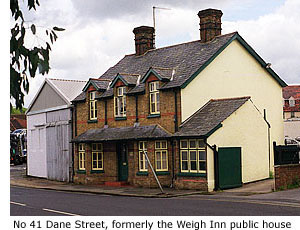 Another former 19th century public house is No 41 Dane Street, a double fronted detached building currently used as business premises. This was the Weigh Inn, named as such because the small building adjoining it was once a weighhouse operating an adjacent roadside weighbridge. Why there was a weighbridge here is unclear but it was possibly to check the weight of carts delivering malt to the many maltings in the area at that time.
Another former 19th century public house is No 41 Dane Street, a double fronted detached building currently used as business premises. This was the Weigh Inn, named as such because the small building adjoining it was once a weighhouse operating an adjacent roadside weighbridge. Why there was a weighbridge here is unclear but it was possibly to check the weight of carts delivering malt to the many maltings in the area at that time.
The pub itself ceased trading in the early 1900s but in 1929 the property is recorded as St Gabriel’s, a Church of England mother and baby home run by the St Alban’s Diocesan Girls Aid Association. What happened to the property after the mother’s home closed, is currently unknown.
An entrance next to this building leads to Red Lion Court, a large housing development built in the 1980s on the former site of the Match factory.
The short stretch of road here was first called The Dells. In the 19th and early 20th century the large, timber-clad building next to the railway line was a granary serviced by its own railway siding. Its forecourt later became a coal yard but is currently used by Allinson as a staff car park.
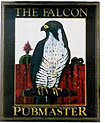 The building at the corner of Station Road and Dane Street was formerly the Falcon public house. Built in the 19th century by Hawkes Brewery, and originally named the Dells, it was a regular haunt of the many maltsters who worked in this vicinity. In 1882 it was run by Alfred J. Reeve, coal merchant, and the following year was extended and faced with large stones.
The building at the corner of Station Road and Dane Street was formerly the Falcon public house. Built in the 19th century by Hawkes Brewery, and originally named the Dells, it was a regular haunt of the many maltsters who worked in this vicinity. In 1882 it was run by Alfred J. Reeve, coal merchant, and the following year was extended and faced with large stones.
Falcon pub formerly the Dells  In 1891 the pub was recorded as having a blacksmith’s forge and stabling for five horses. And between 1903 and 1939 was used by Bishop’s Stortford football club as both a changing room and social club. After the war the club moved back to the Chequers Hotel in North Street where it was first formed in 1874 (See Guide 6 – Chequers Hotel).
In 1891 the pub was recorded as having a blacksmith’s forge and stabling for five horses. And between 1903 and 1939 was used by Bishop’s Stortford football club as both a changing room and social club. After the war the club moved back to the Chequers Hotel in North Street where it was first formed in 1874 (See Guide 6 – Chequers Hotel).
Despite losing the football club’s lucrative patronage the Falcon’s popularity continued, but by the late 20th century had become yet another victim of Stortford’s diminishing ‘pub’ trade. Finally closing in 2005, the Falcon was then modernised and refurbished under private ownership and in July 2007 reopened as The Fountain – an ‘up-market’ bar allowing entrance only to those over 25 years of age and enforcing a strict dress code, which forbids the wearing of caps and hats. Maltsters must be turning in their graves!

